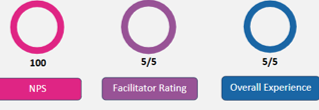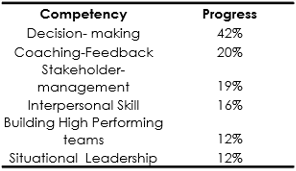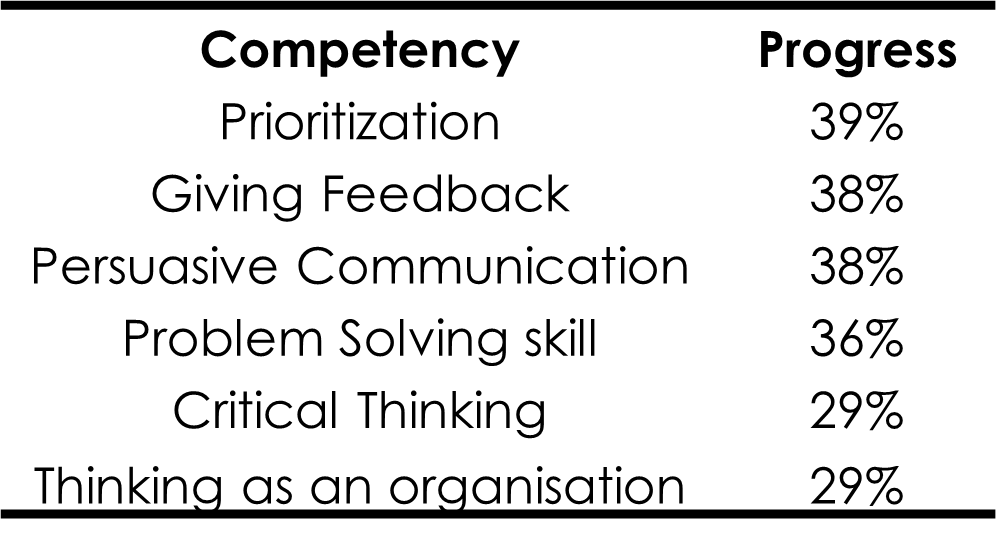Why Soft Skills Training Matters More Than Ever!

In today’s work environment, technical skills alone are insufficient. Soft skills training is crucial to complement technical abilities. Soft skills include effective communication, collaboration, and emotional intelligence. As workplaces become more diverse, developing a well-rounded skill set is essential.
Skills like leadership and management have become a much bigger priority for most companies, jumping ten percentage points year over year, from 40% to 50%, while over the last few years, the proportion of companies addressing empathy and interpersonal skills has doubled.
This article explores the significance of soft skills, provides examples, and offers insights on designing effective training programs for professional excellence.
To give you a high-level overview, here are some key takeaways from this article:
- Soft skills complement technical skills and are essential for success in today’s work environment.
- Soft skills training is crucial for employees to communicate effectively, work collaboratively, and manage their emotions.
- Soft skills are in high demand, and employees with stronger soft skills are more likely to excel in their careers.
- The article will cover the definition and importance of soft skills, examples of key soft skills, benefits of soft skills training, designing an effective training program, implementing training, overcoming training challenges, and emphasizing continuous development.
What are the Key Soft Skills?

Now, let’s dive deeper and understand the key soft skills that are relevant in today’s workplace.
Some of the key soft skills are:
- Communication skills: Effective communication is crucial to convey ideas, collaborate with colleagues, and build strong relationships with clients. It includes verbal communication, non-verbal communication, and written communication.
- Interpersonal skills: Interpersonal skills are the ability to interact positively with others and build strong relationships. It includes active listening, empathy, negotiation, and conflict resolution.
- Team collaboration: Collaboration is the ability to work effectively with team members to achieve common goals. It includes sharing ideas, providing feedback, and valuing diversity.
- Leadership: Leadership is the ability to motivate, inspire, and guide others towards a shared goal. It includes decision-making, delegation, and problem-solving.
- Adaptability and resilience: It is the ability to adapt to changing environments, learn from mistakes, and manage stress. It includes flexibility, perseverance, and emotional intelligence.
Example of soft skills in the workplace

Imagine for a moment, you are in a team meeting, and you need to present an idea to your colleagues. You need effective communication skills to convey your thoughts clearly and persuade your colleagues to support your idea. You also need interpersonal skills to listen actively to their feedback and address their concerns.
Let’s look at another example; there is a conflict between two team members over project ownership. You’d need conflict management skills to resolve the conflict peacefully and ensure that both team members’ concerns are addressed.
Here’s another scenario; you are a team leader and need to delegate tasks to your team members while ensuring everyone is working towards a shared goal. Here, you need leadership skills to motivate your team, provide guidance, and hold them accountable for their work.
The Many Benefits of Soft Skills Training

Now that we understand the importance of soft skills, let’s explore the benefits of soft skills training. Soft skills training helps employees develop crucial abilities to enhance their job performance, improve collaboration, and achieve their career goals. Here are some of the benefits of soft skills training:
- Enhanced Communication and Interpersonal Skills: Soft skills training helps employees improve their communication skills, allowing them to communicate effectively with their colleagues, managers, and clients. It also helps develop interpersonal skills such as empathy and active listening, improving relationships with peers.
- Improved Team Collaboration and Conflict Resolution: Soft skills training helps team members work together more effectively by encouraging collaboration, trust, and respect. It also teaches conflict resolution techniques that enable employees to address differences and find a common ground.
- Effective Leadership and Decision-making: Soft skills training teaches leadership skills such as delegation, problem-solving, and critical thinking, empowering employees with the necessary skills to become more effective leaders. It also helps them make informed decisions by analyzing problems and considering various solutions.
- Adaptability and Resilience in a Changing Environment: Soft skills training helps employees become more adaptable to change while maintaining their resilience. It allows them to embrace change and uncertainty, and persist in the face of challenges.
Designing an Effective Soft Skills Training Program

Designing an effective soft skills training program involves identifying training objectives, assessing skill gaps, developing training content and methods, and providing ongoing support and feedback. Here are some key steps to design a successful soft skills training program:
- Identifying Training Objectives and Target Audience: The first step to designing an effective training program is to establish clear objectives and identify the target audience. The objectives should be specific and measurable, and the target audience should be identified based on their roles and skill levels.
Companies often identify broad training needs sourced from business teams, the nuance of the needs often getting lost in translation between the employee/manager sensing it and the trainer delivering the training. While designing the training, it is important for the trainer to craft the training based on gathering data from all key stakeholders of the training. For example, when we design learning programs for our clients, we make sure to listen to business stakeholders, training participants, and governance stakeholders to clarify training objectives. - Assessing Current Skill Gaps: Once you have identified your objectives and target audience, assessing the current skill gaps is the next crucial step. Conducting a skills gap analysis helps identify areas where employees need training and helps develop a customized training program.
There are many methodologies to conduct this analysis. For example, one way we do a quick skill gap analysis at Meeraq is to do a dipstick study that captures the current knowledge and behavioural preferences of the participants around the skill being trained for. The result of the dipstick helps us define the focus of our learning programs. - Developing Training Content and Materials: After identifying the skill gaps, the next step is to develop training content and materials. Creating engaging and relevant content that aligns with the training objectives ensures employees remain interested and invested in the training program. Examples of training content include videos, role-plays, case studies, and interactive sessions.
Soft skills are best learned through practice. Our sessions include a lot of group work, role-plays, and demonstrations as needed. This focus on practising the soft skill being honed while still in the classroom helps the learner find confidence to continue their journey outside the classroom as well. - Selecting Training Methods and Techniques: Once you have developed training content and materials, select the training methods and techniques based on the target audience and training objectives. There are various training methods available, including in-person, online, blended, and on-the-job training.
While post-covid, many companies prefer having their trainings conducted in-person, we’ve realized that a blended approach helps us create impactful learning journeys that last many weeks longer than the training day, support employees on their practice journey, and keep costs reasonable. - Incorporating Real-life Scenarios and Role-plays: To ensure the effectiveness of soft skills training, it is essential to incorporate real-life scenarios and role-plays. These activities simulate real-world experiences, allowing trainees to practice and apply their newly acquired skills.
Besides being real-life, we’ve understood that these exercises must also be ‘relevant’. People learn the best when they can immediately identify with a scenario that directly mimics the situations that gave rise to the training need in the first place. - Providing Ongoing Support and Feedback: Providing ongoing support and feedback is the final critical step in designing an effective training program. This support could include coaching, mentoring, and on-the-job feedback. Assessing the training program’s effectiveness through feedback sessions and evaluations helps identify areas for improvement and reinforces the importance of continuous development.
As part of ongoing support, we ensure we reconnect with our learners periodically to refresh, celebrate, unblock, and inspire them to continue their practice.
Implementing Soft Skills Training

Once you have designed an effective soft skills training program, it’s time to implement it. This is a big and sometimes daunting step.
Here is a simple checklist to help you implement your soft skills training program effectively:
A. Choose the Delivery Methods: In-person, Online, or Blended
Decide on the delivery method that best suits your training objectives, target audience, and budget. In-person training sessions are ideal for small groups where you can interact with your participants face-to-face. Online training programs are beneficial for employees who work remotely or have a busy schedule. Blended training programs combine online and in-person training methods to maximize the benefits of both.
B. Create Engaging and Interactive Learning Experiences
One of the most critical factors that determine the effectiveness of training is its ability to engage participants. You can ensure that your training program is engaging by using a variety of mediums such as videos, infographics, case studies, and real-life scenarios.
C. Utilize Technology and Learning Platforms
Invest in learning platforms such as learning management systems (LMS) and e-learning tools to make your training programs more interactive and engaging. Online platforms can help you track your employees’ progress and provide data-driven insights to improve training outcomes.
D. Facilitate Workshops and Training Sessions
Ensure that you have skilled facilitators who are proficient in soft skills and can lead training sessions effectively. Facilitators should have industry-specific experience and be able to relate to participants to make the training sessions more practical and relatable.
E. Measure Training Effectiveness and Impact
To ensure that your training program is delivering its desired outcomes, you need to find an objective way to measure its effectiveness. You can choose to conduct surveys, assessments, and feedback sessions to gather data on training outcomes. Measuring the training impact will help you identify areas for improvement and enhance the training program’s long-term success.
Overcoming Challenges in Soft Skills Training

Implementing a soft skills training program can be challenging, due to various reasons such as:
A. Resistance to Change and Mindset Shift
Many employees resist change, and soft skills training is no exception. For example, some employees may feel that their current skills are sufficient, or they may not see the value or relevance of improving their soft skills. To overcome this challenge, it’s important to communicate the benefits of soft skills training effectively, in a way that every kind of employee can see it. This would include giving practical, moral, emotional and theoretical reasons for improving these skills, as well as giving evidence of how training can enhance these skills. Use relevant case studies and testimonials to demonstrate how the training can benefit them in their current role, but more importantly, in their future career development.
B. Addressing Individual Learning Needs
Not all employees have the same learning needs. Some may need more guidance and support, while others may prefer a self-paced approach. To overcome this challenge, it’s essential to understand your employees’ learning needs and tailor the training program accordingly. Use assessments and surveys to gather insights on their learning preferences and adapt the training delivery model accordingly.
C. Sustaining Behavior Change and Application of Skills
One of the biggest challenges of soft skills training is ensuring sustainable behavior change and application of skills on the job. To overcome this challenge, incorporate post-training support mechanisms such as coaching, mentoring, or peer-to-peer learning. Encourage participants to continue practicing their newly learned skills in the workplace and recognize their efforts and achievements.
Conclusion
In conclusion, soft skills are essential to professional success, and soft skills training is the key to unlocking this potential. Investing in soft skills training not only helps improve communication, teamwork, and leadership abilities but also creates a more positive and productive work environment.
To design an effective soft skills training program, you need to identify training objectives, assess current skill gaps, develop training content, and select appropriate training methods. Once the program is designed and implemented, it’s essential to ensure that it is engaging, interactive, and supported by technology.
While implementing a soft skills training program may present some challenges, such as resistance to change and addressing individual learning needs, overcoming these challenges can lead to behaviour change and the application of new skills.
Above all, continuous soft skill development is very important in today’s fast-paced work environment, where adaptability and resilience are key to success. By incorporating soft skills development into your overall development strategy, you can ensure that you and your team stay ahead of the competition.












